
The thing about Ken is that he doesn’t have one. Mattel’s gentleman companion for Barbie, its Ken doll, came into the world without junk and remains that way. His lack of genitalia is a running joke: Ken is synonymous with dicklessness, as multiple references in pop culture attest—lines in Dogma, Sisters, and the 2016 reboot of Ghostbusters, to name a few. “Give Ken-Doll Crotch here two weeks, tops,” said the successful Derek (Adam Scott) of his manchild brother/new employee Brennan (Will Ferrell) in Step Brothers. And this isn’t just something people say in movies; earlier this year, the real-life Stephen Colbert described the equally real Rick Santorum as “Ken doll with even smoother genitals” on The Late Show with Stephen Colbert.
As a kid, I didn’t think Ken’s crotch was funny; I found it frustrating. Every ostensibly male doll I came across, and growing up with four younger sisters, there were a lot, I pantsed in the hope of an eyeful of plastic dick. As a kid growing up in the ’80s who very much wanted to look at penises—any penis, even a fake plastic penis would do—it was a rough time. Dicks were even rarer commodities in movies and especially on TV than they are today. It was especially maddening because there were no shortage of boobs to ogle, if only I had wanted to.
Every ostensibly male doll I came across I pantsed in the hope of an eyeful of plastic dick.
I had a sense of wanting to see dicks way before I had any sense of wanting to do anything with them or their owners, and it seemed unfair as an aspiring connoisseur that the entertainment around me gave me no access to the goods. Barbie had boobs, I reasoned crudely, having no idea that that her lack of nipples was what made them socially acceptable for children to look at. Why couldn’t Ken have a penis?
The answer, it turns out, is intricate and somewhat bizarre. Ken was not merely dickless by default; the bulge was the result of careful strategizing to which his inventors, businessmen, a psychologist, and Japanese manufacturers all contributed. Despite all this planning, Ken still came to represent things his parent company never intended, as icons tend to do. The story of Ken’s crotch is not merely one of PR, manufacturing, and/or branding—it’s about which realities our culture deems acceptable, and which that it seeks to keep hidden. This goes not just for the doll, but for the man he was named after, Ken Handler, who died in 1994 with major parts of his life airbrushed out of public view.
Ken (full name: Kenneth Sean Carson) was released in 1961 expressly to provide Barbie with a boyfriend. He was named after Ken Handler, son of Ruth and Eliot Handler, who ran Mattel. Ken Handler was a teen at the time of Ken’s debut. His legacy would become inextricably linked with the namesake doll that eventually he’d come to resent.
Like a perverted and plastic riff on the old chicken-or-egg cliche, Ken’s crotch was a key feature of his own conception. In his 1987 book Children’s Advertising: The Art, the Business and How it Works, former Mattel ad man Cy Schneider described the question of what to put between Ken’s legs as “a hot internal issue” and surmised that Barbie’s breasty appeal had something to do with it. Mattel’s Ruth Handler, who invented Barbie (based on the German Bild Lilli doll), wanted Ken at least to have a bulge, according to Robin Gerber’s 2009 book Barbie and Ruth. Handler thought that the design team lacked the guts to give Ken even the suggestion of genitalia, reports Gerber. Handler had been met with some resistance from Eliot as well as the design team when conceiving Barbie—the men felt that no parents would buy a doll with breasts for their children. They were wrong, she was right.

After pressing, Handler was able to persuade the design team to make mockups hinting at Ken’s genitals. Three were made: “One was—you couldn’t even see it. The next one was a little bit rounded and then next one really was. So the men—especially one of the vice presidents—were terribly embarrassed,” recounted early Barbie clothing designer Charlotte Johnson in M.G. Lord’s 1994 book Forever Barbie: The Unauthorized Biography of a Real Doll.
“None of us wanted a doll with a penis showing,” Handler is quoted in that book as saying. “If the child took off the swimsuit, we felt it would be inappropriate with an adult boy to show the penis—so we all reached a conclusion that he should have a permanent swimsuit.”
Johnson disagreed—she did want a doll with a penis showing and not some painted briefs: “Do you know what every little girl in this country is going to do? They are going to sit there and scratch that paint off to see what’s under it. What else would they do?”
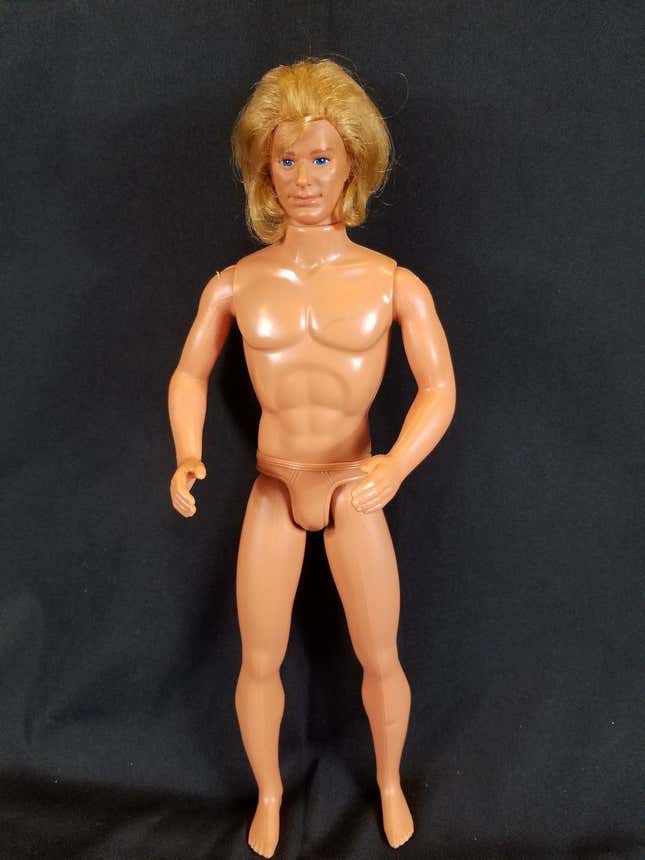
There was some certainty that Ken’s junk would be of particular interest to Barbie’s audience of children. Psychologist, marketing expert, and the “father of motivational research,” Dr. Ernest Dichter had been commissioned to observe little girls playing with Barbies. Schneider talked to him directly and reported in Children’s Television.
“He pointed out the primary play mode for the Barbie and Ken dolls was dressing and undressing them,” wrote Schneider. “He questioned whether children would understand that Ken was a boyfriend or comprehend what a boyfriend really was. Would they see Ken as their fathers, brothers, or the boy next door? And if so, was it healthy to see him undressed? And when he was naked, why did he or didn’t he look like Daddy or a brother?”
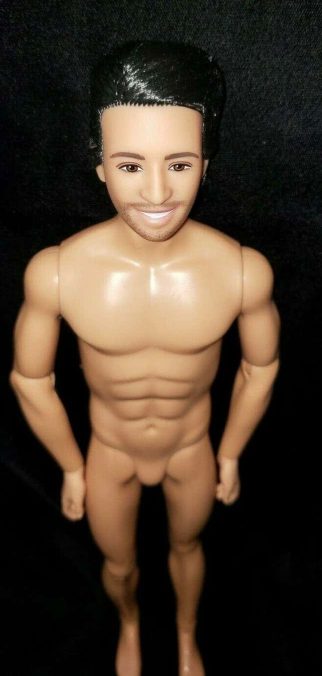
From the early mockups, Johnson claimed that she and Handler chose the Ken of medium hung-ness “as being the one that was nice-looking.” However, according to Schneider, Ken’s package got a bump down during the manufacturing process, when it was determined that the molding on the shorts was too difficult for the plant in Japan to make—and that the large, rounded lump added a cent and a half to the cost of the doll. An engineering supervisor “arbitrarily” eliminated both. Nonetheless, Ken did end up with something down there, a nudge of a bulge that to scale might have resembled a hockey puck.
So Ken came into the world with the smoothness that has been so mocked in pop culture. Historically, some variations of the toy have had embossed underwear the same color of his flesh, while some are completely smooth, suggesting just about nothing. Marvin Barab, director of marketing research for Mattel from 1959-65, is quoted in Barbie and Ruth as saying, “They decided it was better for Mattel if he was neutered, and that was the end of it.” Ultimately, this made no difference to consumers, according to Schneider.
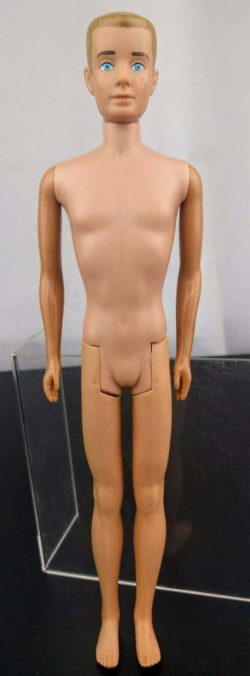
“Children did not think Ken had been in some horrible accident,” wrote Schneider. “Those issues had all been concerns of adults who had over-stressed the problem. Ken was, and still is, accepted as a necessary escort to many of Barbie’s activities. There was a lesson in this for all of us: do not substitute your own tastes, thoughts, or imagination for a child’s.”
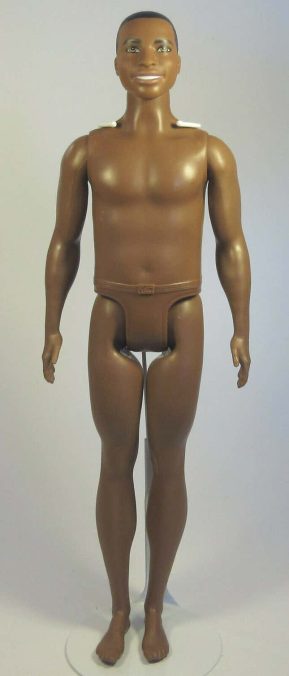
All that hand- and dick-wringing for nothing. Ken’s penislessness seemingly did not affect his bottom line. The doll’s overall anodyne nature was merely reaffirmed by his lack of a dick, to hear some experts tell it. He was devised as a “fantasy escort” for Barbie and, according to Schneider, “Mattel was careful to give him boyish, clean-cut looks and the overall, non-threatening, asexual appearance of a wimpy little jerk.” In Forever Barbie, however, Lord notes a sort of compensatory dog-whistling via plastic add-ons. Lord writes that the accessories that came with Ken’s first garments sold separately from the doll, “came with long, thin accessories—symbols for the penis he lacked. A log stick with a school pennant accompanied his ‘Campus Hero’ outfit; an electric shaver with a dangling cord accompanied his bathrobe; and his weekend ‘Casuals,’ khakis and a T-shirt, came with car keys.”
By 1963, two years after the successful launch of Ken, his phallic stand-ins had become “outrageous” in Lord’s assessment: a rifle with hunting outfit, a baseball bat, a pendulous stethoscope, and a long fork skewering a pink plastic weenie in the “Cheerful Chef” iteration of Ken.
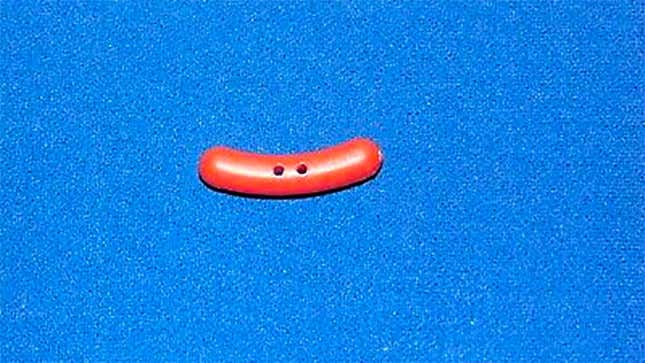
Mattel itself drew inadvertent attention to Ken’s lack of a penis when it released the notorious Earring Magic Ken in 1993. With his close-cropped blonde hair, shiny lavender vest with a matching mesh shirt underneath, and of course, earring, this Ken became a minor sensation amongst gay men who spotted the signs and claimed Earring Magic Ken as one of their tribe. And, as Dan Savage pointed out in a piece published a few months after the doll’s release, “hanging around Ken’s neck, on a metallic silver thread, is what ten out of ten people in the know will tell you at a glance is a cock ring.”

Mattel manager of marketing and communications Lisa McKendall repeatedly denied to the press that Ken was packaged wearing a tool designed to make his dick harder and last longer in bed. “We’re not in the business of putting cock rings into the hands of little girls,” she told Savage. Though there are many accounts of Earring Magic Ken’s success, Mattel stopped making the doll seemingly within a year.
Both Ken’s penisless existence and his emergence as a gay icon in the early ‘90s are somewhat relevant to the biography of Ken Handler, the son of Ruth and Eliot Handler who inspired Ken’s name. Ken Handler, according to several accounts, was embarrassed to share a name with a doll that didn’t have genitalia (and would become primarily known for lacking packing). The real Ken, despite having a wife with whom he had three children, also had sex with men, according to Robin Gerber’s 2009 book Barbie and Ruth, as well as Jerry Oppenheimer’s dishy 2009 book Toy Monster: The Big, Bad World of Mattel.
Ken Handler, according to Gerber’s book, also loathed the body-image issues his parents’ company seemed to instill in young girls. Pivoting from the family business, Ken Handler was a musician, he put up an art show about the AIDS crisis in 1987, and he directed some movies, including the raunchy ‘80s comedy Delivery Boys. The movie’s young breakdancing, pizza-delivering characters found themselves in a variety of sexual predicaments. One got a boner that he just couldn’t get rid of and obscured from an interrogating cop via a pizza box; another, to escape the lavish house of a love interest, wore drag and pretended to be a newly employed part of the family’s help. The horny father attempted to coerce him into giving him oral sex through a glory hole he had installed in his room. The bewigged delivery boy escaped unharmed by smearing the father’s genitals with whipped cream and having the house dog lick them, to the delight of his oblivious harasser.
Both Gerber’s and Oppenheimer’s books claim that when Ken Handler died at age 50 in 1994, it was of AIDS. The Handler family allegedly sought to suppress this information, which was not mentioned in his obituaries. “Various versions of his cause of death circulated—that he died of a disease he picked up in his exotic travels, that he died of encephalitis or of a brain tumor, as was reported in Ruth’s obituary in the New York Times and Los Angeles Times eight years after his death,” wrote Gerber, in reference to the trips Ken had made to the Amazon in search of treatment.
The story gets slightly stranger from there, because it was Ken Handler’s doctor, Dr. Pamela Harris, who confirmed his diagnosis and spoke of treating him. She’s quoted separately in Gerber’s and Oppenheimer’s books. Gerber told me by phone that she’d already heard rumors of Ken’s cause of death when she began writing Barbie and Ruth, but she found her first proof of it when she gained access to a box of restricted materials in the Mattel archive. After some persuading, Elliot Handler, who was still alive at the time (he died in 2011), eventually gave Gerber permission to examine the contents of the box, which contained Ruth Handler’s letters to Dr. Harris. Gerber was living in D.C., at the time and Harris, who worked there too, met her for coffee.
Gerber remembered Dr. Harris as initially “reticent” but she would go on to share the story of Ken Handler’s diagnosis, as well as her breaking the news with Ken to his wife Suzie (who stayed with him), and informing his parents of their son’s disease alongside Suzie while Ken walked on the nearby beach, not wanting to face them during the reveal. Ruth Handler resolved to help her son get treatment in the days before HIV was a truly treatable disease.
How the remaining members of Ken Handler’s family felt about his disease finally being reported with credible sourcing is something of a mystery. After I contacted Dr. Harris about speaking to reporters about her patient’s status and cause of death, she sent me back a response telling me not to quote her. She did not respond to further inquiries. Nor did Stacey Handler, Ken Handler’s daughter, nor a Samantha Handler that I have good reason to believe is another daughter of Ken and Suzie’s. Mattel also refused to comment on this matter.
Both Oppenheimer and Gerber told me that they never heard from Mattel or the Handlers regarding the contents of their books, which are both proudly unauthorized. Gerber told me that she knew that Mattel did not like Barbie and Ruth after a chilly interaction at a toy convention, though that may have had more to do with her centering her narrative on Ruth Handler. At the time of her book’s publication, Gerber said, the toy company was attempting to downplay Ruth Handler’s historical significance. However, Gerber has since worked with Mattel again—she wrote Barbie Forever: Her Inspiration, History, and Legacy, an authorized coffee table book that came out in September. Gerber says Mattel’s management has changed in the 10 years since her book’s release. Apparently no grudge is being held against the author and her tea spilling.
In her 1994 blend of history and criticism, Barbie’s Queer Accessories, academic Erica Rand interpreted the hubbub at Mattel over representing Ken’s penis versus the seeming nonissue that Barbie’s lack of genitalia was to be “sexist and heterosexist presumption.”
“It’s no surprise that Mattel considered the penis to be a crucial feature of girls’ sexual fantasy and psychological health, given the assumption widely promoted by Freud and his followers that child psychosexual development hinges on the discovery of the penis—not the vagina, which, overall, is rarely described as something to see—followed by an immediate realization of the penis’s great value and an inevitable conclusion that people who don’t have one are incomplete or wounded,” Rand continued.
With now 25 years passed and considerable advances made in (at least liberal) society of what constitutes manhood, the Rand of today expressed a different interpretation of Ken’s crotch when I recently reached her by phone.
“What does it mean to think about this topic when we have a broader understanding of the relationship between genitals and gender? This idea that Ken is a man without a penis, what does that actually mean?” she said. “If we think now that in a way there’s no such thing as one male body, if you identify as a man, you have a male body, whatever parts you come with would be my view of things now. If you’re a trans man, you might not have come with what Ken didn’t come with either. If you’re a trans woman, you’re still a woman even if you started out life with a penis. That makes me think of things a little differently.”
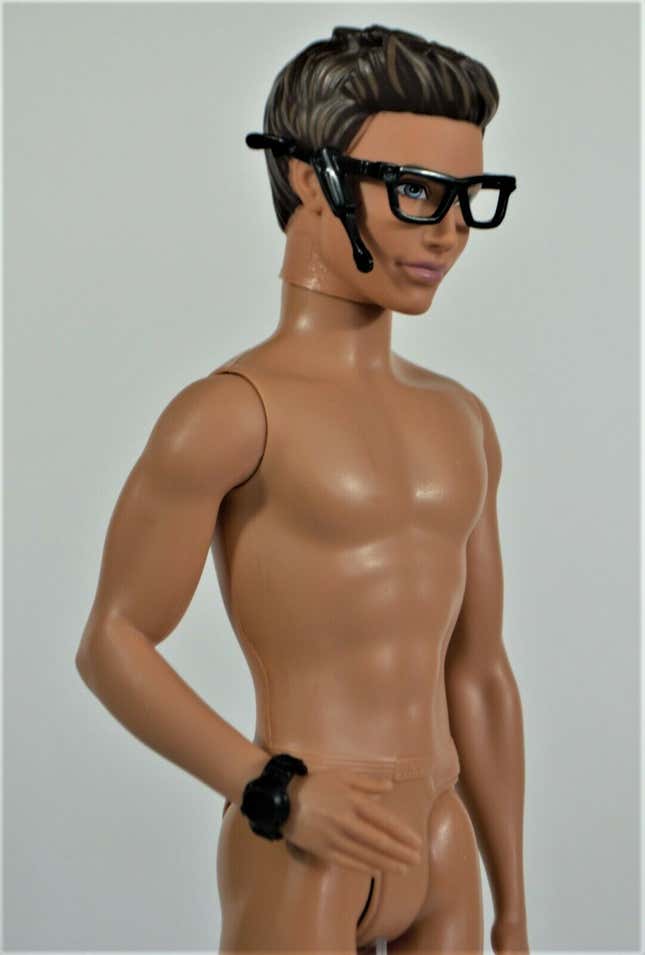
While the manufacturing, PR, and representational considerations made by Mattel in the early ‘60s seemed to have nothing to do with an open-minded interpretation of gender (and this was decades before “transgender” was even a word in wide usage), it is more than a little odd in retrospect that the toy company mass marketed a vision of manhood that was pointedly not defined by what was between Ken’s legs. In retrospect, it almost seems forward-thinking.